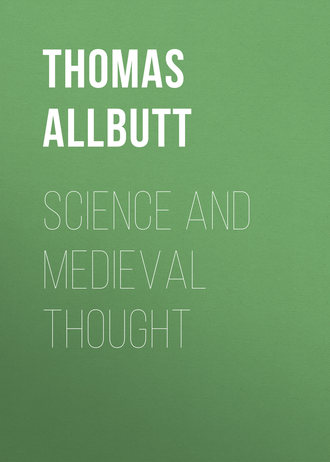 полная версия
полная версияScience and Medieval Thought
71
Galileo and Kepler had proved the validity of terrestrial physics and mathematics in astronomy. Aristotle of course was the first to apply physics to astronomy, but wrong physics.
72
With which Malpighi was in close association.
73
The Consilia medica, or Consultations, were published records, either of particular cases or of diseases in a more general sense, which seem to have been instituted by Thaddæus of Florence in the thirteenth century, were abundant in the fifteenth, and were continued into the sixteenth, and even later. In the fifteenth century these records have a considerable historical value, and no little clinical interest, as the questions to the patient and the records of symptoms are often orderly and graphic, and enable the modern reader to revise the diagnoses, many of them grotesque enough. These Consilia make a great bulk of matter, and one which has not been thoroughly explored. A general account of the Consilia may be read in any good history of medicine, but perhaps the most interesting is to be found in the chapters on medieval medicine in Daremberg’s “Histoire et Doctrines” (e.g. tom. 1. p. 334 et seq.).
74
Originally by Fracastorius, Montanus and others, in the former half of the sixteenth century. Caius in England, Mercado in Spain, Baillou in Paris, if not bedside teachers, had done good clinical work, in Consilia and otherwise, in the same century. What Fracastorius did for syphilis, Caius did for the sweating sickness, and Mercado for petechial typhus. Baillou was too dependent upon the letter of tradition.
75
Even Descartes has some share with Hegel in the profound error that whatsoever is clearly and definitely conceived is true. The inference if true for formal logic, is not true for natural processes; for instance, Descartes’ well-known attribution of the soul to the pineal gland, because all other parts of the brain are double, and the soul is single!
76
“The share of Servetus was small”; that is, the effect of his remarkable discovery was small, for it was buried in a theological work of which but a few copies were rescued from the burning; namely “Christianismi restitutio. Viennæ Allobrogum, 1553.” (Haeser gives the reference to pp. 170-177, De Trinitate divina.) The work was reprinted at Nuremberg in 1790.
77
Quæ, simul æthereos animo conceperat ignes,
Ore dabat vero carmina plena dei. Ovid, Fasti i, 473.

